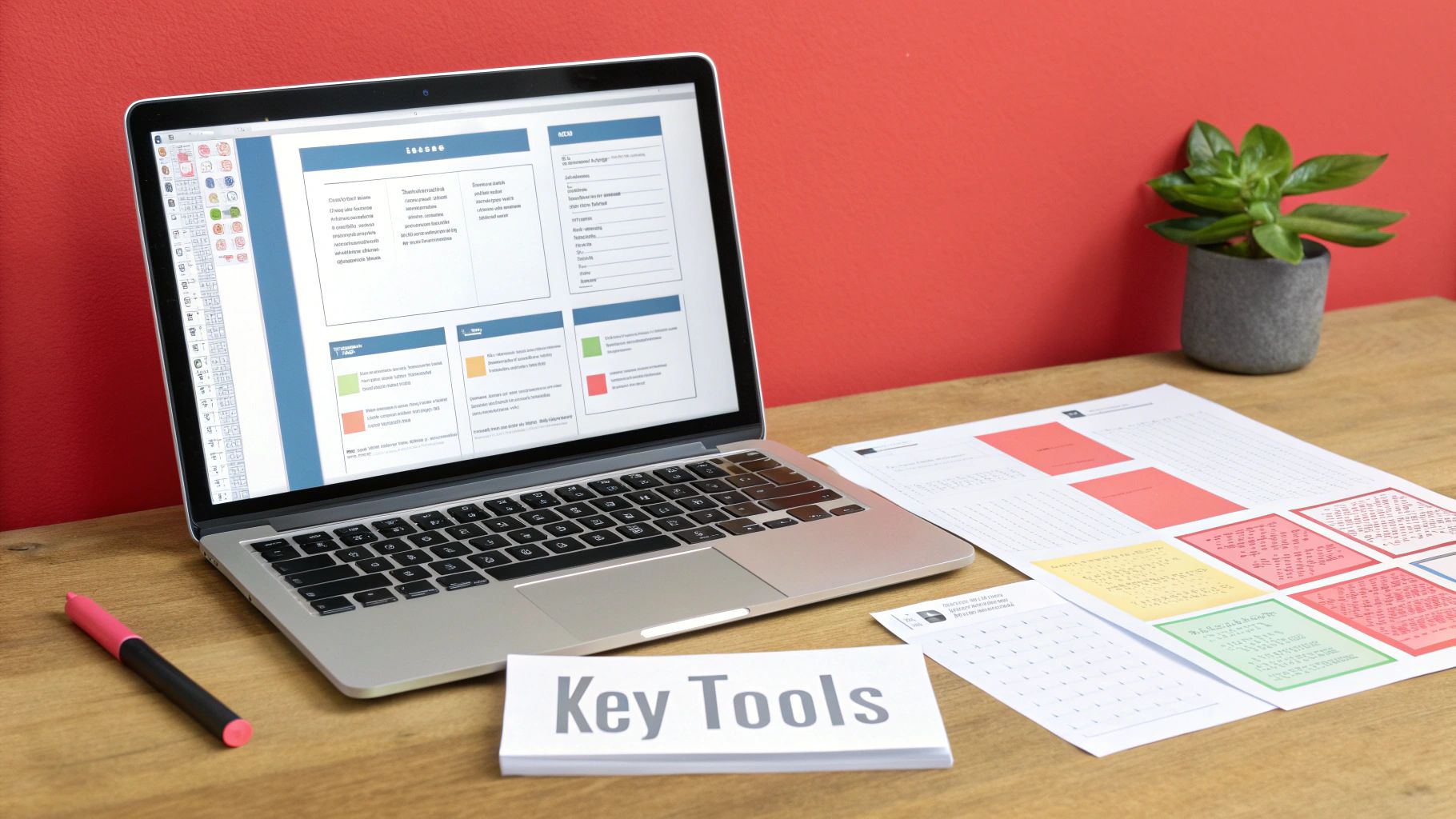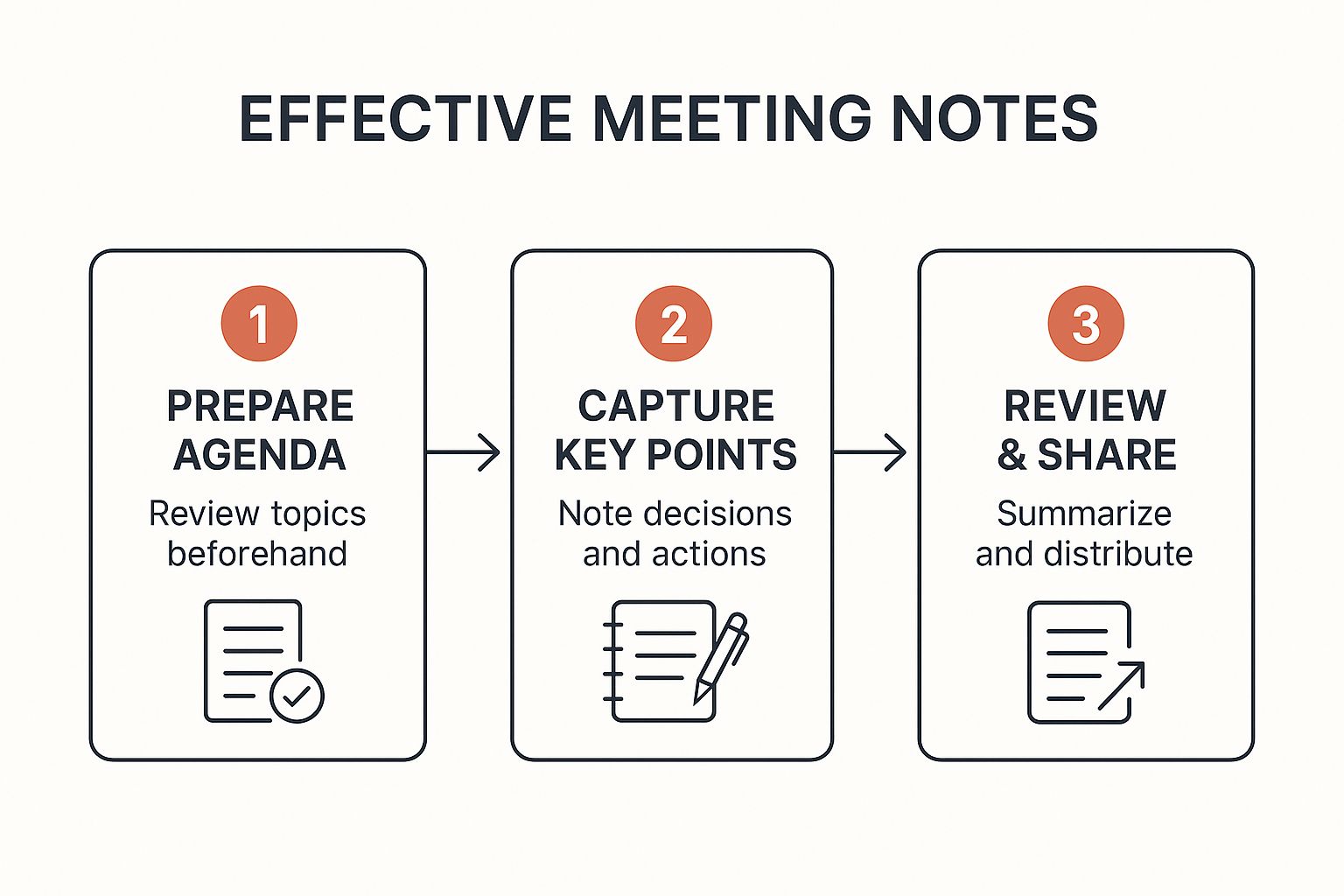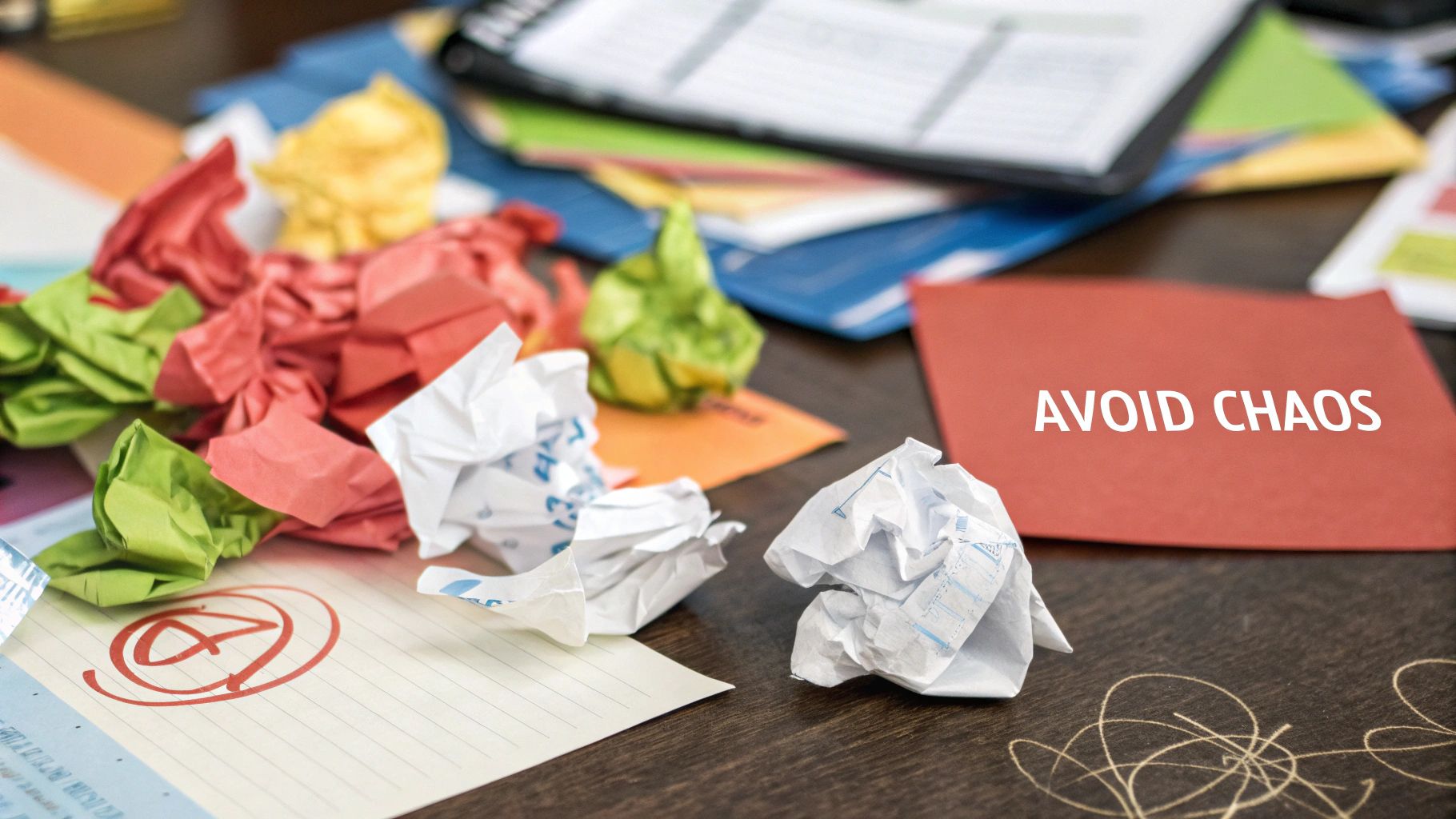For any agency, meeting notes aren't just an administrative chore—they're a high-ROI activity. I've seen it time and time again: clear, actionable notes are the single best defense against expensive scope creep, client misalignment, and sinking project profitability. The alternative? Vague, incomplete notes that lead directly to rework, frustrated clients, and lost revenue. It's that simple.
Why Ineffective Meeting Notes Are Quietly Killing Your Agency's Bottom Line
Let's be blunt. Unproductive meetings and sloppy notes are costing your agency a lot more than just wasted time. They're a silent financial drain, eating away at your profit margins with every misunderstood comment or forgotten decision. For agencies juggling multiple clients and complex projects, the fallout from bad note-taking snowballs, creating friction that grinds projects to a halt and shatters client trust.
This isn't just about being organized; it's a fundamental business process. When notes are ambiguous, your team is left to guess. A designer might take a client's casual "what if" as a direct order, burning hours on unbillable revisions. A developer could spend a week building a feature based on a half-remembered conversation, only to discover it's the opposite of what the client actually wanted. That's not just rework; it's a recipe for blown deadlines and damaged relationships.
The Hidden Financial Costs of Vague Client Communication
The real cost goes way beyond billable hours. Think about these all-too-familiar agency nightmares, all fueled by poor notes:
- The Scope Creep snowball: During a call, a client mentions a "nice-to-have" feature. Without a clear note distinguishing it from a core requirement, it somehow makes its way into the project scope, bloating the budget and pushing back the launch date.
- The Disconnect delivery: Your team proudly presents work they believe is pitch-perfect. But the client is upset because a critical piece of feedback from a meeting two weeks ago was never written down or acted on. This kind of mistake erodes confidence and can put the entire account on shaky ground.
- The Vanishing upsell: A client offhandedly mentions a new business challenge they're facing. A sharp account manager would flag this as a potential upsell opportunity. But if that comment is lost in a sea of conversational fluff, a lucrative new project disappears before it even existed.
These situations are brutally common, and they all trace back to one thing: a failure to take meeting notes seriously. This isn't just an agency problem, either. Ineffective meetings are estimated to cost the U.S. economy a staggering $37 billion every year. When you consider the millions of meetings happening daily, the financial hit from poor documentation is massive. If you want to dig into the numbers, you can explore the full research on meeting statistics.
The most expensive phrase in the agency world is, "I thought you meant..." Clear notes get rid of that ambiguity. They replace risky assumptions with a documented source of truth that protects both your team and your client relationship.
When you look at the stark contrast between well-documented meetings and those left to memory, the business impact becomes undeniable.
How Effective vs. Ineffective Notes Impact Key Agency Metrics
The takeaway is clear: the path you choose has a direct, measurable impact on your bottom line.
Ultimately, treating note-taking as an afterthought is one of the costliest mistakes an agency can make. By reframing it as a critical pillar of project profitability and client satisfaction, you can turn a simple habit into a powerful strategic advantage.
How to Prepare for Meetings to Maximize Note-Taking Success

Here's a hard truth: exceptional meeting notes are born from solid preparation, not just fast typing. For any agency, walking into a client meeting unprepared is like starting a design project without a brief—it’s a recipe for wasted effort and confusing outcomes.
From my experience, the most productive sessions are won long before they even begin. It all comes down to a deliberate pre-meeting ritual. This goes way beyond just having an agenda; it’s about crafting a purpose-driven one.
A truly effective agenda doesn't just list topics. It clearly states the desired outcome for each point. Is the goal to get a decision? To brainstorm ideas? Or just to provide an update? Defining this upfront is critical. It focuses the conversation and makes it infinitely easier to take meeting notes that are actually relevant and actionable.
Step 1: Build a Purpose-Driven Agenda for Client Meetings
Think of a strong agenda as your agency's roadmap for the conversation. For a critical client kick-off, this means detailing every single item that needs approval before your team can start billing hours. For an internal creative review, it means outlining the specific feedback you need from each team member. No more vague "thoughts on the design?" prompts.
A game-changing part of this prep is pre-loading your agenda into a tool like Scribbl. When you share it beforehand, everyone shows up aligned and ready to contribute. This one simple step eliminates that dreaded first ten minutes of "so, what are we talking about today?" chatter and sets a professional, efficient tone from the get-go.
A well-structured agenda shared in advance is the single greatest tool for preventing meeting derailment. It turns a potential free-for-all into a focused, outcome-oriented discussion.
To make sure your prep is consistent across all your different meetings, a checklist is your best friend. It creates a repeatable process that guarantees nothing falls through the cracks, whether you're meeting with a brand-new client or just syncing with your internal team.
Step 2: Use a Pre-Meeting Checklist for Agency Success
Here’s a practical checklist your agency can adapt to prime every single meeting for success:
- Define a Clear Objective: What's the single most important thing we need to achieve? Write it right at the top of the agenda. Seriously.
- Assign Key Roles: Who is the facilitator? Who's the final decision-maker? Most importantly, who is the dedicated note-taker? This role should go to someone who can focus only on capturing information, not leading the discussion.
- Structure Agenda with Outcomes: Frame each agenda item as a question to be answered or a decision to be made. Instead of a lazy "Discuss new ad creative," use an action-oriented "Decide on final ad creative for Campaign X."
- Pre-load & Distribute: At least 24 hours in advance, load the agenda into your meeting tool and share it with all attendees. This gives clients and team members time to actually prepare their thoughts.
By adopting these pre-meeting rituals, you shift the team's focus from simply talking to actively accomplishing. This level of preparation is a cornerstone of effective meeting management and sets the foundation for capturing notes that actually drive projects forward.
For a deeper look into this, check out our guide on meeting management best practices for more tips.
A Framework for Capturing What Actually Matters in Agency Meetings

You’ve done the prep work. The agenda is set. Now for the hard part where so many agency teams drop the ball: capturing the gold during a fast-paced client call or a chaotic internal brainstorm.
The natural instinct is to furiously type everything you hear, essentially turning yourself into a human transcriptionist. Trust me, that’s a losing battle. You’ll miss the forest for the trees every time.
Your real job is to be a filter, not a stenographer. It’s not about documenting the conversation; it’s about documenting the outcomes of that conversation. This is all about learning to separate firm decisions and critical action items from the background noise.
This is exactly where an AI note-taker like Scribbl becomes your agency's secret weapon. It handles the heavy lifting of transcribing everything, creating a perfect record of who said what. This frees up your human note-taker to focus on the high-value stuff—capturing the nuance, context, and intent that an AI might miss.
How to Distinguish Actionable Signal from Meeting Noise
During any given meeting, information is flying at you from all directions. A client casually mentions a new competitor. A designer suggests a minor color tweak. A project manager confirms a deadline. Not all of this is created equal.
Your team needs a system for deciding what makes it into the final notes. Here’s a simple framework agency teams can use to separate critical signals from distracting noise:
- Firm Decisions: These are the non-negotiable agreements that move the project forward. Think: "The client has officially approved the final logo design" or "We are moving the launch date to July 15th." These need to be captured verbatim.
- Critical Action Items: These are specific, assigned tasks that have a person's name and a deadline attached. For example, "Sarah to send the revised mockups to the client by EOD Friday." No ambiguity.
- Key Client Feedback: This is about capturing the client's voice, either through direct quotes or strong sentiment. Noting down "I'm concerned about the user experience on the checkout page" is vital for preventing disagreements later and, more importantly, showing the client you’re actually listening.
- Background Noise: This is everything else—the friendly chatter, the sidebar conversations, the ideas that were floated but never landed. Let the AI transcript catch this stuff; it doesn't belong in your primary, actionable notes.
Let's face it, the time we spend in meetings is already massive. Employees in the UK and U.S. spend around 11.3 hours per week in meetings. That adds up to over 16 full workdays a year. With that kind of time investment, every minute has to deliver value.
For an agency, the best meeting notes aren't the longest—they're the clearest. They zero in on decisions, ownership, and next steps, cutting through the fluff to create a direct path forward.
Having a solid structure before the meeting even starts helps your note-taker operate with this kind of precision. This is where a well-crafted agenda, which we talked about earlier, is absolutely essential. If you need a good starting point, check out our guide on creating a great client meeting agenda template.
Example: Taking Notes in a Client Scope Review Meeting
Let's put this into practice. Imagine you're in a scope review for a new website build. The conversation is jumping between design, functionality, and budget—a classic agency scenario.
Here’s how a skilled note-taker, backed by an AI assistant, would capture the key points. Instead of a messy, chronological brain dump, their notes would be structured for immediate clarity and action.
Decisions Made:
- Platform: Confirmed build on Shopify Plus.
- Homepage Hero: Client approved Concept B (the video-centric version).
- Payment Gateway: Stripe will be the primary processor.
Action Items:
- [OWNER: Alex - PM] - Get final quote for the premium Shopify theme by EOD tomorrow.
- [OWNER: Maria - Design] - Create high-fidelity mockups for the approved homepage hero by next week's sync.
- [OWNER: Client - Mark] - Provide final brand assets (logos, font files) by Friday, June 21st.
Key Client Feedback (Verbatim):
- "The mobile navigation in Concept A felt a little clunky. Let's make sure the mobile UX for Concept B is seamless."
- "I love the direction, but we need to be very careful we don't exceed the $25,000 initial budget."
See the difference? This approach transforms your notes from a passive record into an active project management tool. It assigns ownership on the spot and captures client concerns in their own words, which is an invaluable reference point for keeping everyone aligned and protecting your agency from scope creep down the line.
The Post-Meeting Workflow: Turning Raw Notes into Action
Let’s be honest. A meeting's value evaporates the longer those raw notes sit untouched. The energy and clarity from a great client call can quickly turn into a confusing mess of half-remembered conversations and scribbles. The best agencies I've worked with know this, and they have a rock-solid, immediate post-meeting workflow to turn that raw data into forward momentum.
This isn't just about cleaning up typos. It’s about rapidly transforming a transcript into strategic intelligence that pushes projects forward, locks in accountability, and protects your agency. Using an AI tool like Scribbl to generate the initial summary is a massive head start here. It frees you up to focus on structuring the information and defining next steps, rather than getting bogged down in manual transcription.
This entire lifecycle—from prep to follow-up—is a process you can fine-tune for some serious efficiency gains.

This infographic boils the whole process down to three key phases: preparation, capture, and review. It’s a great visual reminder that effective notes aren't a one-and-done task. Each step builds on the last to create a powerful asset for your team.
Step 1: Standardize Your Note Structure for Agency-Wide Clarity
Your very first move after a meeting should be to take the AI-generated summary and whip it into a standardized format. Consistency is everything for agencies. When every team member knows exactly where to find key information, you eliminate guesswork and speed up execution across the board.
A proven structure that works wonders for agencies is leading with the most important stuff first. Don't make busy clients or executives hunt through a wall of text to find the takeaways.
Organize your notes using this hierarchy:
- Key Decisions: Put all firm approvals and final agreements right at the top. This becomes the single source of truth for what was decided. No ambiguity.
- Action Items: Right below decisions, list out a crystal-clear list of tasks. Every single item needs a designated owner and a specific deadline.
- Detailed Summary: The more nuanced discussion points, client feedback, and important context can live below the actionable items.
This "inverted pyramid" style means even the busiest stakeholder can scan the top of the notes in 30 seconds and know exactly what happened and what's next. For more tips on this, check out our in-depth guide on how to take better meeting notes.
An unstructured brain dump of meeting notes creates more work for everyone. A structured summary with clear decisions and actions reduces work by providing instant clarity and direction.
Step 2: Push Action Items Directly Into Your Agency's Workflow
The real magic of modern note-taking is how it plugs into the tools your agency already lives in. Your meeting notes shouldn't die in an isolated document; they need to be pushed directly into your project management system. This is where accountability is truly born.
The financial hit from inefficient meetings is staggering. It goes way beyond just the time spent. A simple 30-minute meeting with three employees can cost a company between $700 and $1,600. For managers, that annual cost can skyrocket to over $43,000. These numbers show exactly why making every meeting actionable is a direct boost to your agency's bottom line.
Imagine this: you hang up from a client call and, with just a few clicks in Scribbl, you automatically create new tasks in Asana or Monday.com directly from your action items. Boom. You've just created a bulletproof link between conversation and execution, closing the loop and ensuring nothing falls through the cracks. When tasks show up right alongside everyone's other project work, there are no excuses.
How to Build a Consistent Meeting Note System Across Your Agency

It’s great when one person on the team is a diligent note-taker. But when your entire agency operates from a consistent, organized system? That’s a genuine competitive advantage.
You move note-taking from a simple personal task to a strategic asset. Suddenly, it’s fueling accountability, deepening client trust, and even protecting your agency’s bottom line.
Of course, a culture like this doesn't just happen. You have to be deliberate and build a system that makes the right way the easy way. It all starts with standardization.
Create Standardized Templates for Core Agency Meetings
Think about it: your agency doesn't run a new client onboarding the same way it runs a quick internal sync. So why would your notes for each be identical?
Creating distinct templates for your core meeting types is the first step. This ensures your team captures the most critical information, no matter the context.
For example, you could set up templates for:
- Client Onboarding: A checklist-style format is perfect here. You’ll want dedicated sections for business goals, target audience details, key stakeholders, and initial project milestones.
- Creative Reviews: These notes need to be focused. Use fields designed for capturing specific, actionable feedback on design, copy, or strategy. A spot for direct client quotes is always a good idea.
- Weekly Syncs: Keep it simple. A three-column structure for "What We Did," "What's Next," and "Blockers" is fantastic for keeping internal projects on track and moving forward.
These templates aren't about adding bureaucracy; they're about building consistency and muscle memory. They guide your team to capture the right information every single time.
A centralized, searchable archive of meeting notes is your agency's institutional memory. It turns past conversations into future insights, preventing you from solving the same problems over and over again.
Build a Searchable Knowledge Base for Client History
The real magic of a great note-taking system kicks in when you can actually find past decisions and discussions without digging through old emails. When you store all your notes in a centralized hub, like the client-specific channels in Scribbl, you create an incredibly powerful knowledge base.
This isn't just about finding that one action item from last month's call. It's about spotting the bigger patterns.
By reviewing notes over time, you can identify recurring project issues, track shifts in a client's mood, or even pinpoint where scope creep usually starts to sneak in. This data-driven approach allows you to proactively fix your processes and strengthen client relationships.
For a deeper dive into making every note a valuable asset, it’s worth adopting established meeting minutes best practices. Integrating these principles will ensure every meeting record contributes to a stronger, smarter agency.
Ultimately, a robust system transforms notes from simple records into strategic intelligence.
Frequently Asked Questions About Agency Meeting Notes
Even with the best systems in place, a few common questions always seem to pop up when agencies try to nail down their note-taking process. Let's tackle them head-on with some practical advice that builds on what we've covered.
Who Is Responsible for Taking Notes in a Client Meeting?
This is a classic dilemma. Ideally, you want to assign a dedicated note-taker who is not the lead presenter or the main account manager. When your lead is splitting their attention between engaging the client and frantically typing, both tasks suffer.
A fantastic approach we’ve seen work wonders is to use an AI note-taker like Scribbl to get a full transcript. This frees up the human note-taker to focus on much higher-value activities—like spotting crucial action items, clarifying decisions, and picking up on the subtle cues of client sentiment that an automated tool might miss. It's the best of both worlds: a complete record plus strategic human insight.
How Soon After a Meeting Should Agency Notes Be Shared?
The clock starts ticking the second the meeting ends. You should aim to clean up, organize, and send out your notes within 24 hours at the absolute maximum. The goal is to keep the momentum going while the conversation is still fresh for everyone.
For really important client meetings—the ones with big decisions or tight timelines—try to send the summary over the very same day. A quick turnaround doesn't just look professional; it ensures critical action items get moving immediately and prevents costly delays.
What Is the Best Format for Sharing Agency Meeting Notes?
The "best" format is whichever one plugs directly into your team's day-to-day workflow. Sending a link to a Google Doc is fine, but it creates another information silo that people have to remember to check.
Real effectiveness comes from pushing those takeaways straight into your project management hub. Exporting action items directly into tools like Asana, Jira, or Monday.com is a game-changer. It makes every task visible, trackable, and accountable right where the work actually gets done. This closes the loop between talking about the work and actually doing it.
Ready to stop losing revenue to bad meetings? Scribbl gives your agency a complete system for capturing decisions, assigning action items, and creating a searchable client knowledge base. Start turning your agency's conversations into profit by trying Scribbl today.




